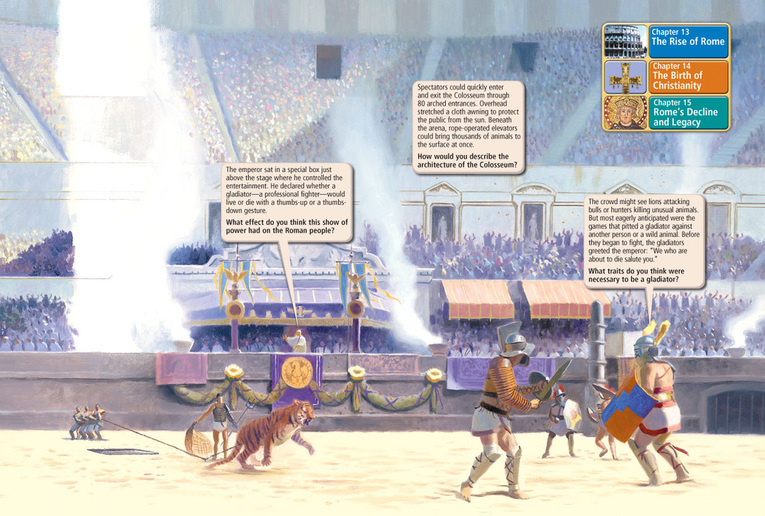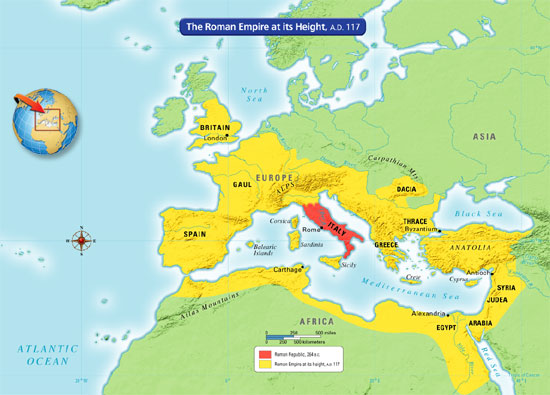The World of Ancient Rome
Watching the Games at the Colosseum, A.D. 80
Emperor Titus has invited all of Rome to celebrate the opening of the new Colosseum with 100 days of festivities and entertainment. Along with about 50,000 others, you have crowded into the arena to see the games. As the action gets underway, the crowd roars with excitement.
What do the games at the Colosseum suggest about the world of ancient Rome?
Emperor Titus has invited all of Rome to celebrate the opening of the new Colosseum with 100 days of festivities and entertainment. Along with about 50,000 others, you have crowded into the arena to see the games. As the action gets underway, the crowd roars with excitement.
What do the games at the Colosseum suggest about the world of ancient Rome?
Rome's Geographic Location
ESSENTIAL QUESTION Why was Rome's location so favorable?
After the overthrow of the Etruscans, Rome grew from a city into a country and then into a vast empire. Its location helped make this growth possible.
Hills and River
In reality, people founded Rome, not figures from legend. The first settlers of Rome were the Latins. They came from a region surrounding Rome. They chose the spot for its mild climate, good farmland, and strategic location.
The Latins and later settlers built Rome on seven steep hills. (See the map below.) During the day, settlers farmed the fertile plain at the base of the hills. At night, they returned to their hilltop homes, from which they could defend themselves against an enemy attack.
ESSENTIAL QUESTION Why was Rome's location so favorable?
After the overthrow of the Etruscans, Rome grew from a city into a country and then into a vast empire. Its location helped make this growth possible.
Hills and River
In reality, people founded Rome, not figures from legend. The first settlers of Rome were the Latins. They came from a region surrounding Rome. They chose the spot for its mild climate, good farmland, and strategic location.
The Latins and later settlers built Rome on seven steep hills. (See the map below.) During the day, settlers farmed the fertile plain at the base of the hills. At night, they returned to their hilltop homes, from which they could defend themselves against an enemy attack.
Rome had other advantages. It was located a short distance from the Mediterranean Sea on several ancient trade routes. It also lay next to the Tiber River. As you learned in the Geography feature above, this river played an important role in Rome's development.
Italian Peninsula
Rome's location on the Italian Peninsula also played an important role in its development. The peninsula stretches south from Europe into the Mediterranean Sea. A peninsula is a piece of land surrounded on three sides by water. The Italian Peninsula is shaped like a boot. Its heel points toward Greece, while its toe points across the sea to Africa.
Italy's location on the Mediterranean made it relatively easy for Roman ships to reach the other lands around the sea. This position made it easier for Rome to eventually conquer and gain new territories. It also helped the development of trade routes.
The two main mountain ranges of Italy helped protect Rome. The Alps border Italy on the north, and the Apennines (AP•uh•NYNZ) form Italy's spine. But Italy's mountains didn't separate early settlements the way the mountains of Greece did. Italy also had more large plains than Greece. This made farming easier.
Why It Matters Now . . .
There are still many cultural connections among Mediterranean areas of Europe, Asia, and Africa as a result of Rome's influence.




